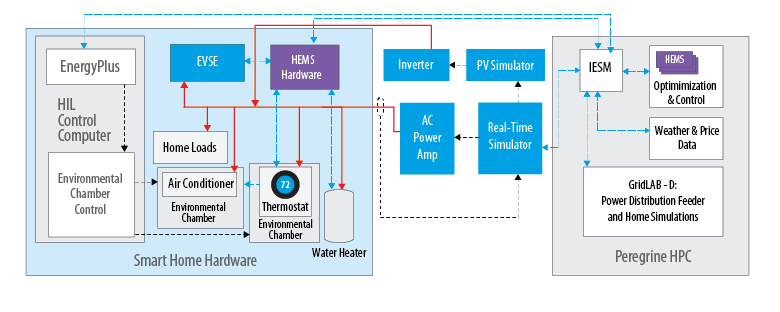Smart Home and Building Systems
At NREL, we are developing and evaluating technologies that make our homes and buildings smarter.
To help advance these technologies and enable their effective integration with the electric grid, NREL has developed a controllable, flexible, and fully integrated lab space dedicated to testing residential and commercial smart energy technologies. The Energy Systems Integration Facility (ESIF) at NREL is a one-of-a-kind testing space that connects appliances, a home, or even a community to an end-to-end energy ecosystem. By incorporating power generation, energy storage, and end loads into the facility, researchers can simulate real-world conditions in a controlled laboratory environment.

The Smart Home Test Bed
Work at the ESIF gives manufacturers, utilities, and researchers a more complete picture of a smart energy device or system's performance, leading to improvements in efficiency, safety, and design.
Learn more about NREL's residential and commercial buildings research.
Download a fact sheet about our smart home and building research
DownloadCapabilities
- Exploring how intelligent building systems and the dynamic grid of the future can work together
- Characterizing energy loads with highly granular energy consumption and service measurements
- Evaluating the features, effectiveness, and energy savings of home energy management systems, nonintrusive load-monitoring systems, and smart appliances
- Interactively tying products and supercomputer simulations together using hardware-in-the-loop technology
- Evaluating how a device or system performs under varying energy supply situations such as grid fluctuations or high concentrations of renewable energy
- Connecting experiments across the lab via alternating current and direct current electrical distribution buses
- Isolating and testing any portion of a home's energy ecosystem, including end loads, transformers, thermal and electrical energy storage, and photovoltaic inverters
- Analyzing an individual home or tie three homes together to evaluate them as a neighborhood
- Exploring functionality, applications, interoperability, and cybersecurity questions related to Internet of Things technologies prior to deployment in the field
- Evaluating new techniques for fault detection and diagnostics for buildings and systems.
Featured Publications
Smart Home Test Bed: Examining How Smart Homes Interact with the Power Grid, NREL Fact Sheet
Energy Systems Integration Facility: Systems Performance Lab, NREL Fact Sheet
Contact
Bethany Sparn
Senior Research Engineer
Bethany.Sparn@nrel.gov
303-384-7442
Team with us to develop innovative home and building technologies
work with usShare
